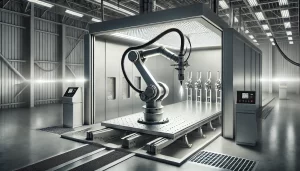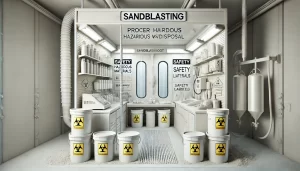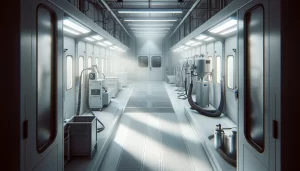When you’re working in industries that involve surface preparation, painting, or refinishing, sandblasting booths are indispensable tools. They quickly remove rust, paint, and contaminants, leaving surfaces clean and ready for a fresh coat or finish. But while sandblasting booths streamline operations, they also generate hazardous waste that requires careful handling and proper disposal. So, how exactly do sandblasting booths manage hazardous waste disposal?
Understanding how sandblasting booths handle hazardous waste disposal is essential not only for safety and compliance but also for protecting the environment and ensuring the sustainability of your business. Let’s dive into what constitutes hazardous waste in a sandblasting context, the typical waste management processes involved, and the importance of proper disposal.
What Makes Sandblasting Waste Hazardous?
Sandblasting, or abrasive blasting, uses high-pressure techniques to clean surfaces, usually involving abrasives like sand, glass beads, aluminum oxide, steel grit, or plastic media. During the blasting process, contaminants such as paint particles, heavy metals, rust, and chemical residues are stripped from surfaces and mixed with the abrasive materials, turning them into waste products.
This combination of abrasive media and removed contaminants often contains hazardous materials. Heavy metals such as lead, cadmium, chromium, and mercury can be present in paints and coatings, making the resulting waste potentially toxic. Without proper disposal, these materials pose significant risks to human health and the environment, contaminating soil, groundwater, and air.
How Sandblasting Booths Collect Hazardous Waste
Modern sandblasting booths are designed with built-in systems that manage waste collection efficiently and safely. These booths typically feature enclosed spaces that prevent hazardous materials from escaping into the surrounding environment, protecting workers and maintaining air quality.
Inside the booth, a powerful ventilation and filtration system captures dust and debris. The abrasive media and contaminants fall into a collection hopper, separating larger particles from finer dust. Airborne contaminants and fine dust are then trapped by advanced filtration systems, such as cartridge filters or baghouses, ensuring minimal release into the atmosphere.
Waste Segregation and Containment
Once collected, the waste from sandblasting booths undergoes a crucial step: segregation and containment. It’s important that hazardous waste is carefully separated from non-hazardous materials to reduce the volume requiring specialized disposal. Segregation typically involves filtering and sorting processes that separate reusable abrasive materials from contaminated waste.
Reusable abrasives can often be recycled multiple times before being disposed of, significantly reducing waste and associated costs. The contaminated materials that cannot be reused are stored securely in designated hazardous waste containers, clearly labeled and properly sealed. This containment prevents accidental exposure and environmental contamination.
Proper Disposal Methods
Once hazardous waste is securely contained, disposal must comply strictly with local, state, and federal regulations. Facilities handling sandblasting waste typically collaborate with certified waste management companies specializing in hazardous waste treatment and disposal. These companies possess the necessary expertise, equipment, and permits to manage hazardous materials safely and responsibly.
Disposal methods vary based on the type and degree of contamination. Some waste may undergo stabilization or chemical treatments designed to neutralize hazardous components, making them safer for landfill disposal. Highly contaminated waste, particularly waste containing heavy metals, often requires disposal in specially permitted hazardous waste landfills designed to prevent environmental leakage.
Regular Monitoring and Compliance
Managing hazardous waste doesn’t end at disposal. Effective sandblasting booth operations include ongoing monitoring and record-keeping. Regular inspections ensure the booth’s waste management systems operate efficiently and safely. Companies are typically required to document waste generation volumes, storage durations, and disposal methods, maintaining detailed records to demonstrate compliance with environmental regulations.
Ensuring compliance with hazardous waste regulations protects your business from potential fines and penalties and safeguards your workers’ health and safety. Companies that prioritize responsible hazardous waste management practices also bolster their reputation as environmentally responsible, sustainable businesses.
Training and Safety Measures
Proper hazardous waste management also heavily depends on personnel training and safety practices. Workers operating sandblasting booths should receive thorough training on identifying hazardous materials, handling waste safely, emergency response procedures, and personal protective equipment (PPE) use. Regular training helps reduce accidents, exposure incidents, and improper waste handling, contributing significantly to workplace safety.
Personal protective gear, including respirators, gloves, protective suits, and eye protection, should always be worn when handling abrasive blasting waste. Additionally, clearly communicated emergency procedures must be in place in case of accidental spills or exposure incidents.
Environmental and Economic Benefits
Proper hazardous waste management in sandblasting booths is not merely a regulatory obligation—it’s also an investment in sustainability and economic efficiency. Recycling and reusing abrasive materials reduce operating costs by cutting down the frequency and volume of abrasive purchases. By minimizing waste, companies reduce disposal costs and lessen their environmental footprint.
Businesses adopting comprehensive waste management systems can often gain a competitive edge by appealing to environmentally conscious clients, partners, and investors. Demonstrating responsible environmental practices enhances brand image, attracts eco-conscious customers, and can qualify companies for certain sustainability incentives or grants.
Final Thoughts
Sandblasting booths are powerful tools for achieving pristine surfaces in preparation for painting or refinishing. However, their effectiveness depends significantly on how well they handle the hazardous waste generated during operation. Proper management and disposal of hazardous materials ensure not only regulatory compliance and worker safety but also protect the environment and enhance your business’s sustainability and reputation.
Specialized Sandblasting Booth Services
We specialize in providing top-quality sandblasting booths and custom finishing solutions tailored to meet the unique needs of various industries. Our expert team designs and manufactures state-of-the-art sandblasting booths that ensure safety, efficiency, and superior performance. From automotive and aerospace to marine and industrial applications, our booths are engineered to handle even the most demanding surface preparation tasks. We offer comprehensive services, including booth installation, maintenance, upgrades, and technical support.




